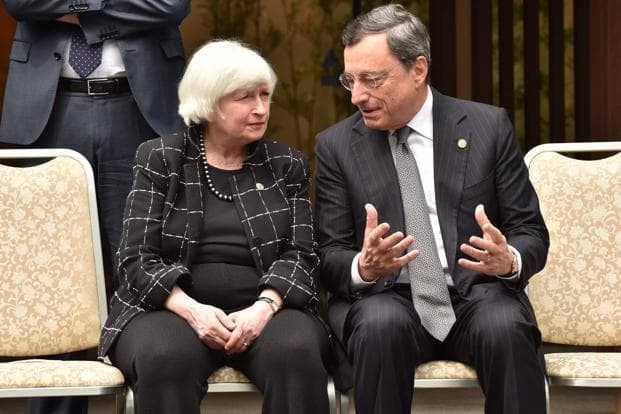 Too much complacency, if we want to summarize the month of June. The market is still expecting a well sustained global growth, although the focus remains on the lack of price pressure. The narrative is the following: investors are still confident about the supportive role of Central Banks and at the same time they are partying a mix set of economic data, better than expected in Europe and in pause-mode in the USA.
Too much complacency, if we want to summarize the month of June. The market is still expecting a well sustained global growth, although the focus remains on the lack of price pressure. The narrative is the following: investors are still confident about the supportive role of Central Banks and at the same time they are partying a mix set of economic data, better than expected in Europe and in pause-mode in the USA.
I would like to focus on two big events that characterized the beginning of the summer. Two Central Bankers pointed out their next steps, but different reactions occurred after their speeches.
During the conference of the June FOMC, Janet Yellen, Chair of the Federal Reserve, appeared to be very confident about the economic health of the Country by raising the GDP growth projection and by lowering the unemployment rate expectations. Translating it in numbers the FED is setting its policy to accompany a growth of 2.2 percent in 2017 versus 2.1 percent earlier and a lower level of unemployment, 4.3 percent from 4.5 percent.
Indeed, the FED proceeded to hike interest rate for the second time in 2017 despite last core inflation data came at 1.7 percent well below the consensus expectation of 1.9 percent.

Even if the Federal Reserve is expressing caution about the expected level of inflation in the short term (below 2 percent), Yellen is considering this recent softness in data as a pure transitory phenomenon. Still the stabilization around 2 percent over the medium term is a reasonable target since it has not been changed in their expectations.
However, the market reaction seemed to weight more the weakness of hard data rather than a more hawkish than expected Yellen’s stance. A flattening of the yield curve was the final effect, lower yields across the long-end of the Treasury Curve as a clear message sent by investors that are not paying too much attention at Yellen indications. In the end, not even a reduction balance sheet prospective scared the market participants.
ECB President Mario Draghi was the game changer, once again. His credibility overshadowed Yellen’s and imprinted a different narrative to the market.
In fact, at the European Central Bank Forum in Sintra, Portugal, Draghi highlighted the improvement that the Euro Area is experiencing compared to one year earlier. “All the signs now point to a strengthening and broadening recovery in the euro area”. Albeit the dynamics for the inflation are not supportive enough to allow the ECB to exit the stimulus program, both the economy pick up combined to the labor improvement confirmed by latest data, are going to be taken into consideration for the upcoming monetary policy adjustment.
After the meeting in Sintra, it seems that the market is closely monitoring next steps in ECB behavior to understand and better position the portfolio also in relation to the US curve. Basically, the main driver is now the German curve. Still I believe that the potential big looser of a European taper tantrum is the periphery. Overall the trade in place is a liquidity bet and we are entering in the summer section, usually characterized by a lower depth, with evaluation both in equity and bond very stretched. The only rational advice is to maintain a higher level of caution by preferring liquid assets and staying away from overcrowded trades. We learned two big lessons from this hot beginning of the summer: Draghi is still more persuasive than Yellen and there is no enough space if everybody wants to exit from a trade at the same time.
Christian Zorico: LinkedIn Profile

